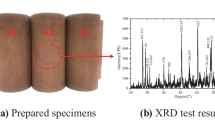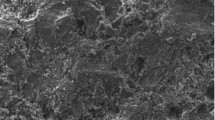Abstract
During oil and gas exploitation in tight sandstone reservoirs, the influence of temperature on the physical and mechanical properties of sandstone cannot be ignored, which is of great significance to the formulation of oil and gas exploitation techniques and the accurate evaluation of recovery. In this article, the physical and mechanical properties of sandstone after thermal treatment from 25 to 800 °C are investigated by laboratory tests. The experimental results indicate that 400 °C is a threshold, and the temperatures of less than 400 °C have little effect on the physical and mechanical properties of sandstone. Poisson's ratio has a sudden change between 400 and 600 °C, and this change can be attributed to the phase transition of quartz at 573 °C. As the temperature increases, the failure behavior of sandstone transforms from brittle to ductile. Subsequently, a Knuth–Durstenfeld shuffle algorithm is introduced to characterize the heterogeneity of rocks considering mineral composition, and this algorithm is verified to better reveal the thermal damage of rocks. The uniaxial compression test of sandstone after thermal treatment is a two-stage damage process, and this process is completely simulated in COMSOL. In addition, a fully coupled thermal–mechanical-damage constitutive model is established to predict the failure process of rocks. The ultimate failure modes of sandstone in the simulation are in good agreement with the experimental results, indicating the reliability of the proposed model.


























Similar content being viewed by others
Abbreviations
- \(T\) :
-
Temperature
- \(\delta (T)\) :
-
Physical properties of sandstone after heat treatment at \(T\)
- \(\delta_{0}\) :
-
Physical properties of sandstone at room temperature
- \(w\) :
-
Rate of change of physical properties
- \(\alpha_{{\text{T}}}\) :
-
Linear thermal expansion coefficient
- \(c\) :
-
Cohesion
- \(\varphi\) :
-
Internal friction angle
- \(\sigma_{1} ,\;\sigma_{3}\) :
-
First principal stress and third principal stress
- \(\sigma_{ij}\) :
-
Cauchy stress tensor component
- \(F_{i}\) :
-
Body force in the i direction
- \(\varepsilon_{ij}\) :
-
Cauchy strain tensor component
- \(u_{i}\) :
-
Displacement in the i direction
- \(\delta_{ij}\) :
-
Kronecker delta
- \(E\) :
-
Young's modulus
- \(K\) :
-
Bulk modulus
- \(\nu\) :
-
Poisson's ratio
- \(\lambda ,\;G\) :
-
Lame constant
- \(\rho\) :
-
Bulk density
- \(C_{{\text{v}}}\) :
-
Specific heat capacity
- \(k\) :
-
Thermal conductivity
- \(Q\) :
-
Source term
- \(t\) :
-
Time
- \(F_{1} ,\;F_{2}\) :
-
Functions of tensile and shear stress state
- \(f_{t0} ,\;f_{c0}\) :
-
Uniaxial tensile strength and uniaxial compressive strength
- \(\varepsilon_{1} ,\;\varepsilon_{3}\) :
-
First and third principal strain
- \(\varepsilon_{t0} ,\;\varepsilon_{c0}\) :
-
Maximum elastic tensile strain and maximum elastic compressive strain
- \(D\) :
-
Damage variable
References
Bi J, Liu PF, Gan F (2020) Effects of the cooling treatment on the dynamic behavior of ordinary concrete exposed to high temperatures. Constr Build Mater 248:118688
Chaki S, Takarli M, Agbodjan WP (2008) Influence of thermal damage on physical properties of a granite rock: porosity, permeability and ultrasonic wave evolutions. Constr Build Mater 22:1456–1461
Chen YL, Ni J, Shao W, Azzam R (2012) Experimental study on the influence of temperature on the mechanical properties of granite under uni-axial compression and fatigue loading. Int J Rock Mech Min 56:62–66
Chen YF, Hu SH, Wei K, Hu R, Zhou CB, Jing LR (2014) Experimental characterization and micromechanical modeling of damage-induced permeability variation in Beishan granite. Int J Rock Mech Min 71:64–76
Chen SW, Yang CH, Wang GB (2017) Evolution of thermal damage and permeability of Beishan granite. Appl Therm Eng 110:1533–1542
Fairhurst CE, Hudson JA (1999) Draft ISRM suggested method for the complete stress-strain curve for intact rock in uniaxial compression. Int J Rock Mech Min 36:281–289
Greaves GN, Greer AL, Lakes RS, Rouxel T (2011) Poisson’s ratio and modern materials. Nat Mater 10:823–837
Griffiths L, Lengliné O, Heap MJ, Baud P, Schmittbuhl J (2018) Thermal cracking in westerly granite monitored using direct wave velocity, coda wave interferometry, and acoustic emissions. J Geophys Res-Solid Earth 123:2246–2261
Horseman ST, McEwen TJ (1996) Thermal constraints on disposal of heat-emitting waste in argillaceous rocks. Eng Geol 41:5–16
Kumari WGP et al (2017) Mechanical behaviour of Australian Strathbogie granite under in-situ stress and temperature conditions: an application to geothermal energy extraction. Geothermics 65:44–59
Lei R, Wang Y, Zhang L, Liu B, Long K, Luo P, Wang Y (2019) The evolution of sandstone microstructure and mechanical properties with thermal damage. Energy Sci Eng 7:3058–3075
Li M, Liu X (2021) Experimental and numerical investigation of the failure mechanism and permeability evolution of sandstone based on hydro-mechanical coupling. J Nat Gas Sci Eng 95:104240
Li LC, Tang CA, Wang SY, Yu J (2013) A coupled thermo-hydrologic-mechanical damage model and associated application in a stability analysis on a rock pillar. Tunn Undergr Space Technol 34:38–53
Li M, Liu X, Li Y, Hou Z, Qiao S (2022) Effect of contact areas on seepage behavior in rough fractures under normal stress. Int J Geomech 22:04022019
Liu S, Xu JY (2015) An experimental study on the physico-mechanical properties of two post-high-temperature rocks. Eng Geol 185:63–70
Liu J, Xue Y, Zhang Q, Yao K, Liang X, Wang S (2020a) Micro-cracking behavior of shale matrix during thermal recovery: insights from phase-field modeling. Eng Fract Mech 239:107301
Liu LY, Ji HG, Elsworth D, Zhi S, Lv XF, Wang T (2020b) Dual-damage constitutive model to define thermal damage in rock. Int J Rock Mech Min 126:104185
Liu X, Li M, Zeng N, Li T (2020c) Investigation on nonlinear flow behavior through rock rough fractures based on experiments and proposed 3-dimensional numerical simulation. Geofluids 2020:1–34
Liu X, Lu W, Li M, Zeng N, Li T (2020d) The thermal effect on the physical properties and corresponding permeability evolution of the heat-treated sandstones. Geofluids 2020:1–16
Mahanta B, Ranjith PG, Vishal V, Singh TN (2020) Temperature-induced deformational responses and microstructural alteration of sandstone. J Petrol Sci Eng 192:107239
Otto C, Kempka T (2015) Thermo-mechanical simulations confirm: temperature-dependent mudrock properties are nice to have in far-field environmental assessments of underground coal gasification. Energy Procedia 76:582–591
Ranjith PG, Viete DR, Chen BJ, Perera MSA (2012) Transformation plasticity and the effect of temperature on the mechanical behaviour of Hawkesbury sandstone at atmospheric pressure. Eng Geol 151:120–127
Sun Q, Zhang WQ, Xue L, Zhang ZZ, Su TM (2015) Thermal damage pattern and thresholds of granite. Environ Earth Sci 74:2341–2349
Tang SB, Zhang H, Tang CA, Liu HY (2016) Numerical model for the cracking behavior of heterogeneous brittle solids subjected to thermal shock. Int J Solids Struct 80:520–531
Tian H, Kempka T, Xu N-X, Ziegler M (2012) Physical properties of sandstones after high temperature treatment. Rock Mech Rock Eng 45:1113–1117
Tian W-L, Yang S-Q, Wang J-G, Zeng W (2020) Numerical simulation of permeability evolution in granite after thermal treatment. Comput Geotech 126:103705
Vidana Pathiranagei S, Gratchev I (2021) Engineering properties of sandstone heated to a range of high temperatures. Bull Eng Geol Environ 80:2415–2432
Wang F, Konietzky H (2019) Thermo-mechanical properties of granite at elevated temperatures and numerical simulation of thermal cracking. Rock Mech Rock Eng 52:3737–3755
Wang F, Konietzky H (2020) Thermal damage evolution of granite under slow and high-speed heating conditions. Comput Geotech 123:103590
Wang Y-T, Zhou X-P (2019) Peridynamic simulation of thermal failure behaviors in rocks subjected to heating from boreholes. Int J Rock Mech Min 117:31–48
Wang Y, Zhou X, Kou M (2018) A coupled thermo-mechanical bond-based peridynamics for simulating thermal cracking in rocks. Int J Fracture 211:13–42
Wang F, Konietzky H, Frühwirt T, Dai Y (2020) Laboratory testing and numerical simulation of properties and thermal-induced cracking of Eibenstock granite at elevated temperatures. Acta Geotech 15:2259–2275
Xiao W, Yu G, Li H, Zhan W, Zhang D (2021) Experimental study on the failure process of sandstone subjected to cyclic loading and unloading after high temperature treatment. Eng Geol 293:106305
Yang S-Q, Ranjith PG, Jing H-W, Tian W-L, Ju Y (2017a) An experimental investigation on thermal damage and failure mechanical behavior of granite after exposure to different high temperature treatments. Geothermics 65:180–197
Yang S-Q, Xu P, Li Y-B, Huang Y-H (2017b) Experimental investigation on triaxial mechanical and permeability behavior of sandstone after exposure to different high temperature treatments. Geothermics 69:93–109
Yang S-Q, Tian W-L, Elsworth D, Wang J-G, Fan L-F (2019) An experimental study of effect of high temperature on the permeability evolution and failure response of granite under triaxial compression. Rock Mech Rock Eng 53:4403–4427
Yang Z, Yang S-Q, Chen M (2020) Peridynamic simulation on fracture mechanical behavior of granite containing a single fissure after thermal cycling treatment. Comput Geotech 120:103414
Yang Z, Yang S-Q, Tian W-L (2021) Peridynamic simulation of fracture mechanical behaviour of granite specimen under real-time temperature and post-temperature treatments. Int J Rock Mech Min 138:104573
Yavuz H, Demirdag S, Caran S (2010) Thermal effect on the physical properties of carbonate rocks. Int J Rock Mech Min 47:94–103
Zhao Z (2015) Thermal influence on mechanical properties of granite: a microcracking perspective. Rock Mech Rock Eng 49:747–762
Zhao Y, Bi J, Wang CL, Liu PF (2021) Effect of unloading rate on the mechanical behavior and fracture characteristics of sandstones under complex triaxial stress conditions. Rock Mech Rock Eng 54:4851–4866
Zhou XP, Bi J (2018) Numerical simulation of thermal cracking in rocks based on general particle dynamics. J Eng Mech 144(1):04017156
Acknowledgements
The research is financially supported by the National Natural Science Foundation of China No. 51779021 and the Fundamental Research Funds for the Central Universities No. 2020CDCGJ021.
Author information
Authors and Affiliations
Corresponding author
Ethics declarations
Conflict of interest
The authors declare that there are no conflicts of interest regarding the publication of this paper.
Additional information
Publisher's Note
Springer Nature remains neutral with regard to jurisdictional claims in published maps and institutional affiliations.
Rights and permissions
About this article
Cite this article
Li, M., Liu, X. Effect of Thermal Treatment on the Physical and Mechanical Properties of Sandstone: Insights from Experiments and Simulations. Rock Mech Rock Eng 55, 3171–3194 (2022). https://doi.org/10.1007/s00603-022-02791-1
Received:
Accepted:
Published:
Issue Date:
DOI: https://doi.org/10.1007/s00603-022-02791-1




